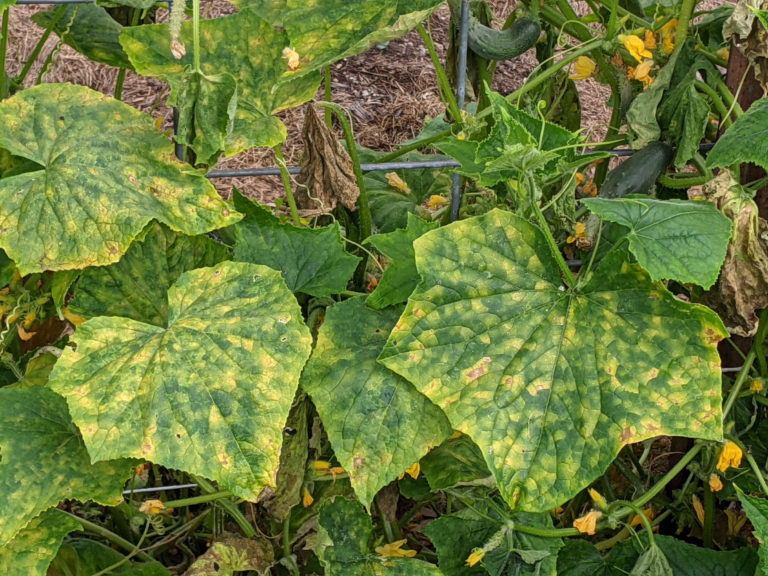Downy Mildew
Disease Identification
Description
Downy mildew is a disease which causes leaf damage to cucurbits (cucumbers, watermelon, etc) resulting in decreases to yield. Signs of the disease begin with older leaves and progress throughout the entire plant as the year progresses. The stem and fruit of the plant will not be directly affected, however, leaf loss will result in less energy being available to fruit growth.
First indications of a downy mildew infection is the appearance of brown spots on leaves. Because other plant disorders look similar, it can be difficult to identify a downy mildew infection at this stage. As the disease spreads, so will the browning on the leaves. Over time, the leaves will begin curling upwards and small white spots will appear on the bottoms of the leaves. At this point, the leaves are no longer photosynthesizing and can be removed, however doing so at this stage will likely not slow the spread of downy mildew.
A plant that has been infected with downy mildew will rarely die. The main issue with the disease is that it looks unsightly and it reduces the photosynthetic ability of the plant which could reduce the ability for the plant to grow and produce fruit.
- Leaves: Light green spots which eventually turn brown. The edges of leaves will begin curling upwards with small white spots appearing on the back side of leaves.
- Stems: Not affected
- Fruit: Not affected
Images
Affected Plants
- Cucurbits
- Cucumber
- Melons
- Summer Squash (Zucchini)
- Winter Squash
Disease Control
Life Cycle
Downy mildew is caused by a fungus that is spread by spores blowing through the air. If a spore from the surrounding area blows into your plot and lands in an area with favorable growth parameters, then it will start spreading.
Like many diseases, Downy mildew favors cool to warm (60 – 80F), moist environments like what is found in many gardens in early and late summer. However, this disease rarely makes an appearance in the early summer because plants are still small which allows air to easily blow around their leaves. As plants get bigger, air has more difficulty moving through the plants which results in more humid conditions increasing the likelihood of disease.
Management
Follow management suggestions in order
- Improve Air Flow: Downy mildew thrives in the warm, humid conditions found among crowded plants in late summer. These crowded plants restrict air from blowing around their leaves increasing the likelihood of disease. The first step is to selectively prune your plants to allow for adequate separation. By removing infected and/or crowded leaves, you can help control the problem if not remove it.
- Improve Watering Methods: When watering your plants, you want to remember two important rules: always water in the morning and always water the ground and not the plant. By watering in the morning, you allow time for the sun and wind to dry off any leaves that happened to be sprayed with water. If you water in the afternoon or evening, water sits on plant leaves increasing humidity and likelihood of disease. If you cannot water in the morning, taking great care to only allow water to hit the soil and not the leaves will go a long way for your garden’s health.
- Chemical Sprays: Copper fungicide is an effective organic control that is readily available in stores. Multiple applications may be necessary for effective control. Addressing mildew early can reduce the need for further controls.


